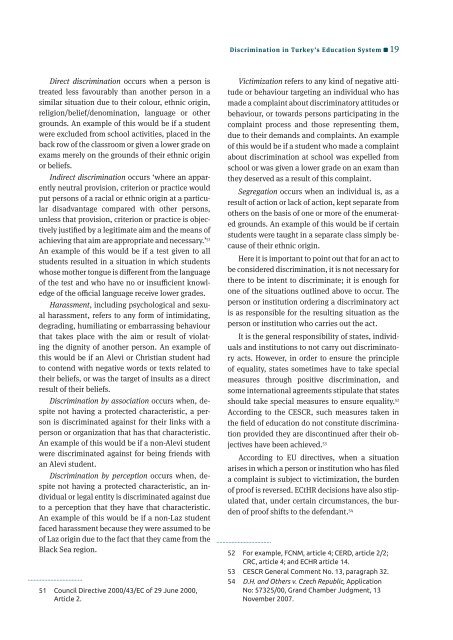Discrimination
EN-turkiye-egitim-sisteminde-ayirimcilik-24-10-2015
EN-turkiye-egitim-sisteminde-ayirimcilik-24-10-2015
Create successful ePaper yourself
Turn your PDF publications into a flip-book with our unique Google optimized e-Paper software.
<strong>Discrimination</strong> in Turkey’s Education System 19<br />
Direct discrimination occurs when a person is<br />
treated less favourably than another person in a<br />
similar situation due to their colour, ethnic origin,<br />
religion/belief/denomination, language or other<br />
grounds. An example of this would be if a student<br />
were excluded from school activities, placed in the<br />
back row of the classroom or given a lower grade on<br />
exams merely on the grounds of their ethnic origin<br />
or beliefs.<br />
Indirect discrimination occurs ‘where an apparently<br />
neutral provision, criterion or practice would<br />
put persons of a racial or ethnic origin at a particular<br />
disadvantage compared with other persons,<br />
unless that provision, criterion or practice is objectively<br />
justified by a legitimate aim and the means of<br />
achieving that aim are appropriate and necessary.’ 51<br />
An example of this would be if a test given to all<br />
students resulted in a situation in which students<br />
whose mother tongue is different from the language<br />
of the test and who have no or insufficient knowledge<br />
of the official language receive lower grades.<br />
Harassment, including psychological and sexual<br />
harassment, refers to any form of intimidating,<br />
degrading, humiliating or embarrassing behaviour<br />
that takes place with the aim or result of violating<br />
the dignity of another person. An example of<br />
this would be if an Alevi or Christian student had<br />
to contend with negative words or texts related to<br />
their beliefs, or was the target of insults as a direct<br />
result of their beliefs.<br />
<strong>Discrimination</strong> by association occurs when, despite<br />
not having a protected characteristic, a person<br />
is discriminated against for their links with a<br />
person or organization that has that characteristic.<br />
An example of this would be if a non-Alevi student<br />
were discriminated against for being friends with<br />
an Alevi student.<br />
<strong>Discrimination</strong> by perception occurs when, despite<br />
not having a protected characteristic, an individual<br />
or legal entity is discriminated against due<br />
to a perception that they have that characteristic.<br />
An example of this would be if a non-Laz student<br />
faced harassment because they were assumed to be<br />
of Laz origin due to the fact that they came from the<br />
Black Sea region.<br />
51 Council Directive 2000/43/EC of 29 June 2000,<br />
Article 2.<br />
Victimization refers to any kind of negative attitude<br />
or behaviour targeting an individual who has<br />
made a complaint about discriminatory attitudes or<br />
behaviour, or towards persons participating in the<br />
complaint process and those representing them,<br />
due to their demands and complaints. An example<br />
of this would be if a student who made a complaint<br />
about discrimination at school was expelled from<br />
school or was given a lower grade on an exam than<br />
they deserved as a result of this complaint.<br />
Segregation occurs when an individual is, as a<br />
result of action or lack of action, kept separate from<br />
others on the basis of one or more of the enumerated<br />
grounds. An example of this would be if certain<br />
students were taught in a separate class simply because<br />
of their ethnic origin.<br />
Here it is important to point out that for an act to<br />
be considered discrimination, it is not necessary for<br />
there to be intent to discriminate; it is enough for<br />
one of the situations outlined above to occur. The<br />
person or institution ordering a discriminatory act<br />
is as responsible for the resulting situation as the<br />
person or institution who carries out the act.<br />
It is the general responsibility of states, individuals<br />
and institutions to not carry out discriminatory<br />
acts. However, in order to ensure the principle<br />
of equality, states sometimes have to take special<br />
measures through positive discrimination, and<br />
some international agreements stipulate that states<br />
should take special measures to ensure equality. 52<br />
According to the CESCR, such measures taken in<br />
the field of education do not constitute discrimination<br />
provided they are discontinued after their objectives<br />
have been achieved. 53<br />
According to EU directives, when a situation<br />
arises in which a person or institution who has filed<br />
a complaint is subject to victimization, the burden<br />
of proof is reversed. ECtHR decisions have also stipulated<br />
that, under certain circumstances, the burden<br />
of proof shifts to the defendant. 54<br />
52 For example, FCNM, article 4; CERD, article 2/2;<br />
CRC, article 4; and ECHR article 14.<br />
53 CESCR General Comment No. 13, paragraph 32.<br />
54 D.H. and Others v. Czech Republic, Application<br />
No: 57325/00, Grand Chamber Judgment, 13<br />
November 2007.


